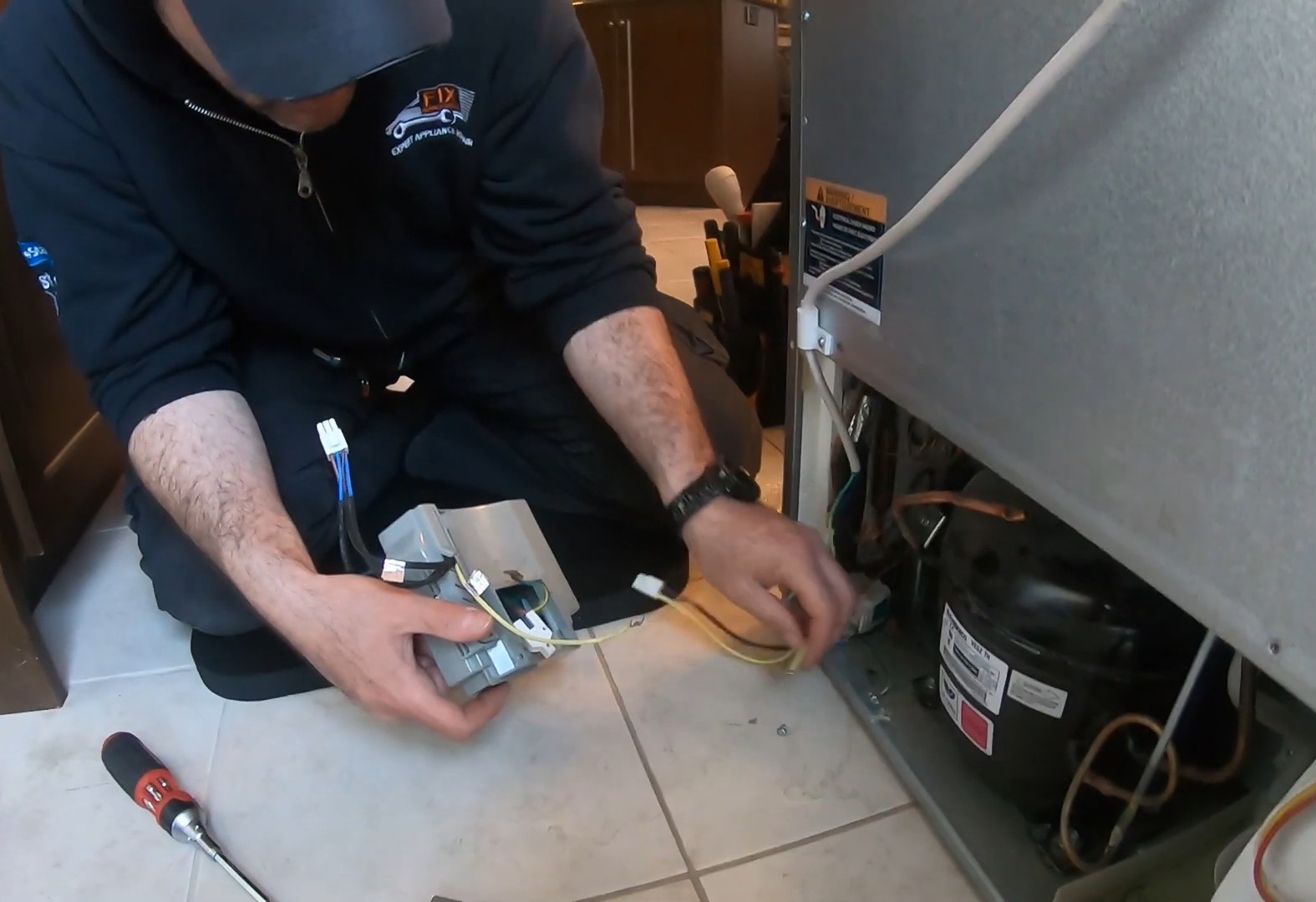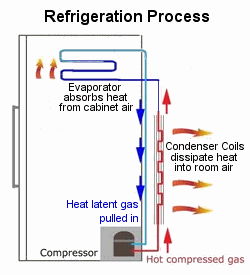Auto defrost fridge problems often stem from issues with the defrost timer, heating element, or thermostat. These components can fail, causing frost buildup and inefficient cooling.
Refrigerators equipped with auto defrost features provide convenience, but they can encounter issues over time. Common problems include excessive frost, inconsistent temperatures, and strange noises. Understanding the causes of these issues can help you troubleshoot effectively. Regular maintenance, such as cleaning the drainage system, can prevent many complications.
Familiarizing yourself with the components of your fridge will empower you to diagnose issues quickly. This knowledge not only saves you time but also extends the lifespan of your appliance. By addressing problems promptly, you can ensure your fridge continues to operate efficiently and reliably.
Introduction To Auto Defrost Fridges
Auto defrost fridges are modern appliances that simplify food storage. They prevent ice build-up and maintain a consistent temperature. Understanding how they work helps in solving common problems.
The Importance Of Auto Defrost Technology
Auto defrost technology offers several benefits:
- Convenience: No manual defrosting is needed.
- Time-saving: Spend less time on maintenance.
- Energy-efficient: Reduces power consumption.
- Food safety: Keeps food fresh longer.
This technology uses a heating element to melt ice. The melted water drains away. This process keeps the fridge operating efficiently.
Common Misconceptions
Many people hold misconceptions about auto defrost fridges:
- They don’t freeze food: Auto defrost fridges can still freeze items.
- They are noisy: Most models operate quietly.
- They use more energy: They are often more energy-efficient than manual models.
Understanding these facts helps in choosing the right fridge. Stay informed to avoid unnecessary issues.
Typical Auto Defrost Issues
Auto defrost fridges simplify our lives. They keep food fresh without much effort. Yet, they can have problems. Understanding these issues helps in quick fixes.
Inconsistent Temperature Woes
Inconsistent temperatures can spoil food. This issue often arises from:
- Faulty temperature sensors
- Blocked air vents
- Damaged door seals
Check the following:
- Ensure the fridge isn’t overstuffed.
- Inspect door seals for damage.
- Clear any obstructions from air vents.
Regular maintenance prevents these problems. Schedule periodic checks to maintain optimal performance.
Noisy Operation And What It Signifies
Noisy operation can be bothersome. Sounds may indicate underlying issues. Common causes include:
- Faulty compressor
- Worn-out fan motor
- Ice buildup in the evaporator
Watch for these noises:
| Noise Type | Possible Cause |
|---|---|
| Buzzing | Compressor issue |
| Humming | Fan motor wear |
| Clicking | Ice buildup |
Addressing these noises early prevents further damage. Regular cleaning and checks are essential.
The Frost-free Failure
The frost-free fridge is a modern convenience. It saves time by preventing ice buildup. However, issues can arise, leading to frustration and food spoilage. Understanding these problems helps in maintaining your fridge efficiently.
Signs Of Defrost System Malfunction
Identifying problems early is crucial. Here are common signs to watch for:
- Frost accumulation on walls or shelves.
- Unusual noises from the fridge.
- Food items freezing in the refrigerator section.
- Water pooling on the floor or inside.
- Unpleasant odors due to spoiled food.
Check your fridge regularly. Early detection can save food and repair costs.
Impact On Food Preservation
A malfunctioning defrost system affects food quality. Proper temperature is essential for preservation. Here are the impacts:
| Impact | Description |
|---|---|
| Freezer Burn | Ice crystals form, ruining texture and flavor. |
| Spoilage | Inconsistent temperatures lead to bacterial growth. |
| Loss of Nutrients | Food loses vitamins over time. |
| Increased Waste | Spoiled food leads to more waste. |
Proper food preservation is vital. Fixing frost-free failures ensures food safety.
Diy Troubleshooting
Facing issues with your auto defrost fridge? Troubleshooting can be simple. Follow these steps to identify and fix common problems. Save time and money with DIY solutions.
Initial Checks And Balances
Start with basic checks to determine the problem:
- Power Supply: Ensure the fridge is plugged in.
- Temperature Settings: Check if the settings are correct.
- Door Seals: Inspect seals for gaps or damage.
- Condenser Coils: Clean any dust or debris from coils.
Simple Fixes You Can Try
Try these easy solutions to fix common issues:
- Reset the Fridge: Unplug for 10 minutes, then plug back in.
- Check the Defrost Timer: Manually advance the timer to test it.
- Inspect the Fan: Ensure the fan is running smoothly.
- Clear Drainage Hole: Remove any blockages from the drainage hole.
These steps can help restore your fridge’s function. Regular maintenance will also prevent future issues.
Advanced Fixes For Persistent Problems
Auto defrost fridges can face stubborn issues. When basic fixes fail, deeper solutions are needed. Understanding the root cause helps you tackle these problems effectively.
When To Delve Deeper
Identify signs that indicate a deeper problem:
- Ice buildup in the freezer
- Unusual noises coming from the fridge
- Inconsistent temperatures
- Water pooling at the bottom
These symptoms often mean a malfunction. Don’t ignore them. Investigate further to prevent damage.
Tools And Techniques For The Ambitious Homeowner
Before starting, gather essential tools:
- Multimeter for electrical testing
- Screwdriver set for opening panels
- Hairdryer to melt ice
- Vacuum cleaner for dust removal
Follow these techniques to fix persistent issues:
- Check the defrost timer: Locate it in the control panel. Test it with a multimeter.
- Inspect the defrost heater: Look for breaks or corrosion. Use a multimeter to ensure it works.
- Examine the thermostat: Ensure it’s functioning properly. A faulty thermostat can disrupt the cooling cycle.
- Clean the condenser coils: Dust buildup can cause overheating. Use a vacuum to clean them.
- Reset the fridge: Unplug for a few minutes. Plug it back in to reset the system.
These steps require patience and care. Always refer to the user manual for specific guidance. Properly diagnosing the issue often leads to effective fixes.

Credit: fixappliances.ca
Maintenance Tips To Prevent Auto Defrost Issues
Maintaining your auto defrost fridge is crucial for its performance. Simple steps can prevent common problems. These tips can help keep your fridge running smoothly.
Regular Cleaning Routines
Cleaning your fridge regularly is essential. Dirt and debris can block vents. This can lead to freezing issues. Follow these steps for effective cleaning:
- Unplug the fridge before cleaning.
- Remove all food items and shelves.
- Use warm soapy water to clean surfaces.
- Check and clean the drain hole.
- Wipe down the door seals.
Schedule cleaning every three months. This helps maintain airflow and efficiency.
Optimal Fridge Settings
Setting the right temperature is key. Ideal fridge temperature is between 35°F and 38°F. Follow these guidelines for optimal settings:
| Setting | Temperature |
|---|---|
| Fridge | 35°F – 38°F |
| Freezer | 0°F |
Check your fridge settings monthly. Adjust as needed based on usage.
Avoid overloading the fridge. This can restrict air circulation. Leave space between items for proper airflow.
Professional Repair Or Replace
Auto defrost fridges are convenient but can face issues. When problems arise, you must decide whether to repair or replace your fridge. This choice impacts your budget and kitchen efficiency. Understanding the signs of trouble helps make the right decision.
Deciding When It’s Time To Call In A Pro
Recognizing when to call a professional is crucial. Look for these signs:
- Fridge is over ten years old
- Frequent breakdowns
- High energy bills
- Unusual noises or smells
- Food spoils quickly
Consult a technician for diagnostic testing. They can identify the root cause. Sometimes a simple fix is all you need. Other times, a replacement is the best option.
The Cost-benefit Analysis Of Repair Vs. Replacement
Weighing repair costs against replacement expenses is essential. Here’s a quick breakdown:
| Option | Cost | Benefits | Drawbacks |
|---|---|---|---|
| Repair | Low to moderate | Extends fridge life | May need more repairs |
| Replace | High | New technology, energy-efficient | Higher initial cost |
Consider these factors before deciding:
- Age of the fridge
- Frequency of repairs
- Energy efficiency ratings
- Your budget
Make an informed choice based on your specific situation. A professional can guide you through this process.

Credit: www.youtube.com
Enhancing Fridge Longevity
Keeping your fridge in top shape is essential. A well-maintained fridge lasts longer and works better. Here are key tips to enhance your fridge’s longevity.
Investing In Quality Spare Parts
Using high-quality spare parts can make a big difference. Here are some benefits:
- Durability: Quality parts last longer.
- Efficiency: They ensure your fridge runs smoothly.
- Safety: Quality parts reduce risks of breakdowns.
Consider these spare parts:
| Part | Function | Recommended Brand |
|---|---|---|
| Compressor | Circulates refrigerant | LG, Whirlpool |
| Thermostat | Regulates temperature | GE, Samsung |
| Fan Motor | Distributes cold air | Frigidaire, Bosch |
Adopting Fridge-friendly Habits
Simple habits help your fridge stay healthy. Follow these practices:
- Keep the door closed.
- Avoid overloading the fridge.
- Regularly clean the coils.
- Set the right temperature (37°F to 40°F).
These actions can prevent many problems:
- Reduces frost buildup.
- Improves energy efficiency.
- Extends the lifespan of your fridge.
Conclusion: Ensuring Fridge Efficiency
Maintaining your fridge’s efficiency is essential for food safety. Understanding auto defrost fridge problems helps prevent issues. Here are key takeaways to keep your appliance running smoothly.
Recap Of Key Tips
- Regular cleaning: Dust the coils to improve airflow.
- Check door seals: Ensure they are tight to avoid leaks.
- Monitor temperature: Keep it between 35°F and 38°F.
- Inspect drainage: Clear any clogs to prevent water buildup.
- Defrost manually: If frost exceeds 1/4 inch, defrost it.
The Value Of Staying Proactive
Proactive maintenance saves money on repairs. It extends the fridge’s lifespan. Regular checks prevent major issues. Schedule monthly inspections for best results.
| Maintenance Task | Frequency | Importance |
|---|---|---|
| Clean coils | Every 6 months | Enhances efficiency |
| Check seals | Monthly | Prevents cold air loss |
| Clear drainage | Monthly | Avoids water damage |
| Defrost | As needed | Maintains performance |

Credit: www.appliance411.com
Frequently Asked Questions
Why Is My Fridge Not Auto Defrosting?
A malfunctioning defrost timer or heater could prevent auto defrosting, leading to frost buildup in your fridge.
How Do I Fix A Fridge Defrost Problem?
Check the defrost timer, heater, and thermostat. Replace any faulty components to restore auto defrost functionality.
What Causes Frost Buildup In My Fridge?
Frost buildup often results from a broken defrost system, door seal issues, or excessive humidity in the fridge.
How Often Should Auto Defrost Occur?
Auto defrost typically occurs every 6 to 12 hours, depending on the fridge model and environmental factors.
Can I Manually Defrost My Fridge?
Yes, manually defrosting can be done by unplugging the fridge and allowing the ice to melt naturally.
Conclusion
Auto defrost fridges can encounter various issues that impact performance. Regular maintenance can prevent common problems. Always check seals and drainage to ensure efficiency. Understanding these issues will help you maintain your fridge better. By addressing problems early, you can prolong its lifespan and save on energy costs.
